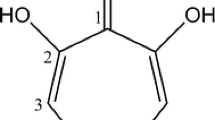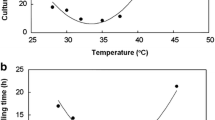Summary
Under conditions of iron-deprivationHafnia alvei (Enterobacteriaceae) produces ferrioxamine G as the principal siderophore. Maximum hydroxamate siderophore production occurred at medium iron limitation. The ferrioxamines were extracted, purified by gel filtration and chromatography on silica gel yielding a major and a minor siderophore fraction. The minor siderophore fraction contained three siderophores, among which ferrioxamine E could be identified by HPLC and FAB mass spectrometry. Reductive hydrolysis of the ferrioxamine G fraction yielded succinic acid and a mixture of diaminopentane and diaminobutane, as determined by gas-liquid chromatography and GLC/MS. HPLC and FAB mass spectrometry confirmed that the ferrioxamine G fraction consisted of two different species, G1 and G2, possessing molecular masses of 671 Da and 658 Da respectively.
Similar content being viewed by others
References
Bergey's Manual of Systematic Bacteriology (1984) Vol. 1, Krieg NR (ed) Williams and Wilkins, Baltimore
Berner I, Winkelmann G (1990) Ferrioxamine transport mutants and the identification of the ferrioxamine receptor protein (FoxA) inErwinia herbicola (Enterobacter agglomerans) Biol Metals 2: 197–202
Berner I, Konetschny-Rapp S, Jung G, Winkelmann G (1988) Characterization of ferrioxamine E as the principal siderophore ofErwinia herbicola (Enterobacter agglomerans) Biol Metals 1: 51–56
Borgias B, Hugi AD, Raymond KN (1989) Isomerization and solution structures of desferrioxamine B complexes of A3+ and Ga3+, Inorg Chem 28: 3538–3545
Braun V (1981) Escherichia coli cells containing the plasmid CoIV produce the iron ionophore aerobactin. FEMS Microbiol Lett 11: 225–228
Braun V, Gross R, Köste W, Zimmermann L (1983) Plasmid and chromosomal mutants in the iron(III) aerobactin transport system ofEscherichia coli. Use of streptonigrin for selection. Mol en Genet 132: 131–139
Csaky TZ (1948) On the estimtion of bound hydroxylamine in biological materials. Acta Chem Scand 2: 450–454
Earhardt CF (1987) Ferrienterobactin transport inEscherichia coli, In: Winkelmann G, van der Helm D, Neilands JB (eds) Iron transport in microbes, plants and animals. VCH Verlagsgesellschaft, Weinheim, pp 67–84
Hantke K (1983) Identification of an iron uptake system specific for coprogen and rhodotorulic acid inEscherichia coli. Mol Gen Genet 191: 301–306
Keller-Schierlein W (1962) 69. Stoffwechselprodukte von Actinomyceten. Ferrioxamine G. Helv Chim Acta 45: 590–595
Keller-Schierlein W, Prelog V (1961) 245. Stoffwechselprodukte von Actinomyceten. Über das ferrioxamine E; ein Beitrag zur Konstitution des Nocardamins. Helv Chim Acta 44: 244–245
Keller-Schierlein W, Mertens V, Prelog V, Walser A (1965) 77. Stoffwechselprodukte von Actinomyceten. Die Ferrioxamine A1, A2 und D2. Helv Chim Acta 48: 710–722
Keller-Schierlein W, Huber P, Kawaguchi H (1984) Chemistry of danomycin, an iron-containing antibiotic. In: Krogsgaard-Larsen P, Christensen SB, Kofod H (eds) Natural products and drug development. Alfred Benzo Symposium 20, Munksgaard, Copenhagen pp 213–225
Konetschny-Rapp S (1990) Neue mikrobielle Eisenkomplexbildner, Screening, Isolierung, Strukturaufklärung und komplexchemische Untersuchungen, Dissertation thesis, University of Tübingen
Langman L, Joung G, Frost G, Rosenberg H, Gibson F (1972) Enterochelin system of iron transport inEscherichia coli: mutation affecting ferric-enterochelin esterase. J. Bacteriol 112: 1142–1149
Rabsch W, Reissbrodt R (1985) Biotest zum Nachweis von Hydroxamat-Fe-Chelatoren. J Basic Microbiol 25: 663–667
Reissbrodt R, Rabsch W (1988) Further differentiation of Enterobacteriaceae by means of siderophore pattern analysis. Zentralbl Bakteriol Hyg A 268: 306–317
Sakazaki R (1981) The genus Hafnia. In: Starr MP, Stolp H, Trüper HG, Balows A, Schlegel H (eds) The procaryotes. Springer, Berlin Heidelberg New York, pp 1181–1186
van der Helm D, Jalal MAF, Hossain MB (1987) The crystal structures, conformations, and configurations of siderophores, In: Winkelmann G, van der Helm D, Neilands JB (eds) Iron transport in microbes, plants, and animals. VCH Verlagsgesellschaft, Weinheim, pp 135–165
Wiebe C, Winkelmann G (1975) Kinetic studies on the specificity of chelate-iron uptake in Aspergillus. J Bacteriol 123: 837–842
Author information
Authors and Affiliations
Rights and permissions
About this article
Cite this article
Reissbrodt, R., Rabsch, W., Chapeaurouge, A. et al. Isolation and identification of ferrioxamine G and E inHafnia alvei . Biol Metals 3, 54–60 (1990). https://doi.org/10.1007/BF01141179
Received:
Issue Date:
DOI: https://doi.org/10.1007/BF01141179




